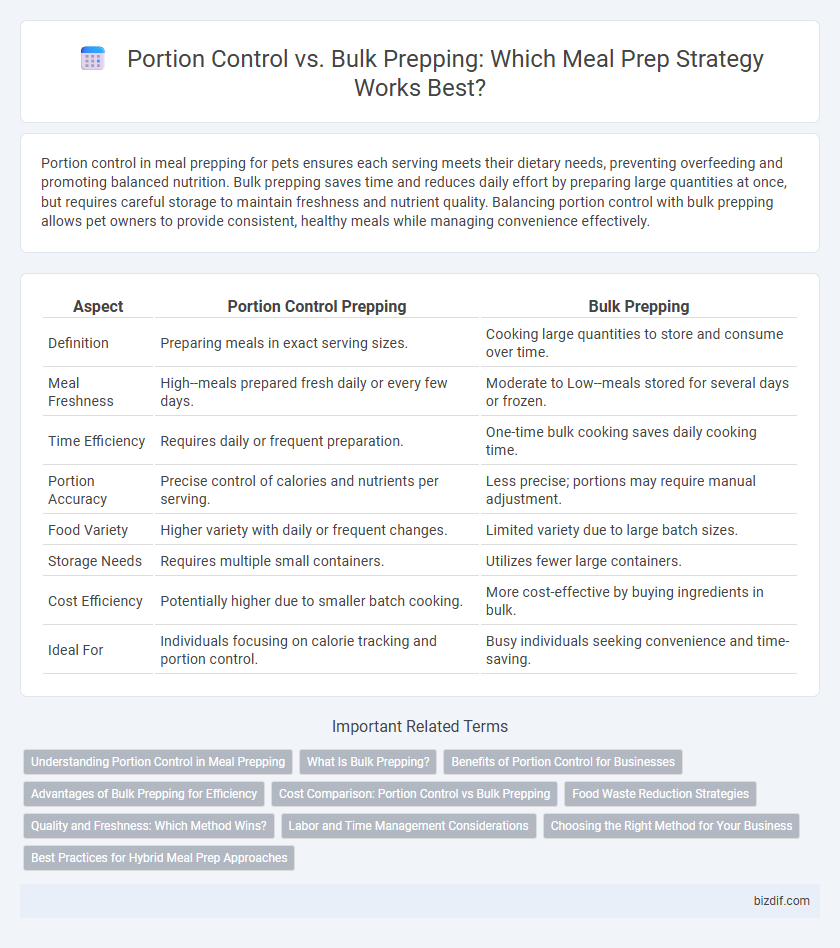Portion control in meal prepping for pets ensures each serving meets their dietary needs, preventing overfeeding and promoting balanced nutrition. Bulk prepping saves time and reduces daily effort by preparing large quantities at once, but requires careful storage to maintain freshness and nutrient quality. Balancing portion control with bulk prepping allows pet owners to provide consistent, healthy meals while managing convenience effectively.
Table of Comparison
| Aspect | Portion Control Prepping | Bulk Prepping |
|---|---|---|
| Definition | Preparing meals in exact serving sizes. | Cooking large quantities to store and consume over time. |
| Meal Freshness | High--meals prepared fresh daily or every few days. | Moderate to Low--meals stored for several days or frozen. |
| Time Efficiency | Requires daily or frequent preparation. | One-time bulk cooking saves daily cooking time. |
| Portion Accuracy | Precise control of calories and nutrients per serving. | Less precise; portions may require manual adjustment. |
| Food Variety | Higher variety with daily or frequent changes. | Limited variety due to large batch sizes. |
| Storage Needs | Requires multiple small containers. | Utilizes fewer large containers. |
| Cost Efficiency | Potentially higher due to smaller batch cooking. | More cost-effective by buying ingredients in bulk. |
| Ideal For | Individuals focusing on calorie tracking and portion control. | Busy individuals seeking convenience and time-saving. |
Understanding Portion Control in Meal Prepping
Understanding portion control in meal prepping enhances calorie management and supports weight goals by precisely measuring food servings. It ensures balanced nutrient intake by dividing meals into appropriate quantities based on dietary needs and prevents overeating. Utilizing portion containers and food scales improves accuracy, making meal prepping more effective for health and fitness outcomes.
What Is Bulk Prepping?
Bulk prepping involves cooking large quantities of meals or ingredients at once, which are then divided into portions for future consumption. This method saves time during busy weekdays and reduces decision fatigue by providing ready-to-eat meals. Unlike strict portion control, bulk prepping emphasizes convenience and efficiency, allowing flexibility in serving sizes based on individual hunger and nutritional needs.
Benefits of Portion Control for Businesses
Portion control in meal prepping enhances inventory accuracy and reduces food waste, which directly lowers operational costs for businesses. Consistent portion sizes improve customer satisfaction by ensuring predictable meal quality and nutritional content, boosting brand reliability. Precise control over ingredient quantities aids in better pricing strategies and streamlines kitchen workflows, increasing overall efficiency.
Advantages of Bulk Prepping for Efficiency
Bulk prepping maximizes time efficiency by allowing the preparation of large quantities of meals in one session, reducing daily cooking time and effort. It ensures consistent portion sizes and meal variety across the week, supporting balanced nutrition and reducing food waste. This method also streamlines grocery shopping and meal planning, enhancing overall organization and cost-effectiveness.
Cost Comparison: Portion Control vs Bulk Prepping
Portion control typically reduces food waste and meal expenses by allowing precise ingredient use, making it cost-effective for individuals with varying dietary needs. Bulk prepping often offers lower ingredient costs per meal due to buying in larger quantities and ingredients in bulk, but may increase upfront spending and risk of unused food spoilage. Evaluating cost efficiency depends on individual consumption patterns, storage capabilities, and meal variety preferences, with bulk prepping usually favored for consistent meal plans and portion control for personalized diets.
Food Waste Reduction Strategies
Portion control in meal prepping minimizes food waste by allocating precise servings tailored to individual consumption, reducing the likelihood of leftovers spoiling. Bulk prepping streamlines cooking processes and ingredient use but requires careful planning, such as freezing portions and using airtight containers, to prevent excess food deterioration. Employing strategies like rotating meals and tracking expiration dates further enhances waste reduction in both methods.
Quality and Freshness: Which Method Wins?
Portion control meal prepping ensures optimal quality and freshness by preparing individual servings just before consumption, reducing the risk of food spoilage. Bulk prepping offers convenience but often compromises freshness as meals are stored for longer periods, leading to nutrient loss and texture degradation. For maintaining superior meal quality, portion-controlled prepping is the preferred method.
Labor and Time Management Considerations
Portion control meal prepping requires careful measuring and dividing food into individual servings, which can be labor-intensive and time-consuming upfront but simplifies daily eating decisions. Bulk prepping involves cooking large quantities of meals at once, saving cooking time overall but often requiring additional effort in packaging and storing to maintain freshness. Effective time management balances the initial labor investment against ease of use throughout the week, with portion control optimizing portion accuracy and bulk prepping maximizing cooking efficiency.
Choosing the Right Method for Your Business
Portion control meal prepping ensures consistent serving sizes, essential for businesses aiming to meet nutritional standards and manage inventory accurately. Bulk prepping offers efficiency in time and resource management, ideal for high-volume operations prioritizing speed and scalability. Selecting the right method hinges on business goals, customer demands, and operational capacity to balance quality and productivity effectively.
Best Practices for Hybrid Meal Prep Approaches
Combining portion control with bulk prepping maximizes meal prep efficiency and nutritional balance by preparing large batches of base ingredients while customizing portions for individual meals. Utilizing airtight containers and digital kitchen scales ensures accurate portion sizes and maintains freshness throughout the week. Incorporating versatile ingredients like quinoa, grilled chicken, and roasted vegetables allows flexible meal combinations that support weight management and reduce food waste.
Portion Control vs Bulk Prepping Infographic

 bizdif.com
bizdif.com